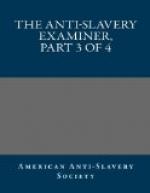ELEAZAR POWELL, Jr.”
TESTIMONY ON THE AUTHORITY OF REV. WM. SCALES, LYNDON, VT
The following is an extract of a letter from two professional gentlemen and their wives, who have lived for some years in a small village in one of the slave states. They are all persons of the highest respectability, and are well known in at least one of the New England states. Their names are with the Executive Committee of the American Anti-Slavery Society; but as the individuals would doubtless be murdered by the slaveholders, if they were published, the Committee feel sacredly bound to withhold them. The letter was addressed to a respected clergyman in New England. The writers say:
“A man near us owned a valuable slave—his best—most faithful servant. In a gust of passion, he struck him dead with a lever, or stick of wood.
“During the years ’36 and ’37, the following transpired. A slave in our neighborhood ran away and went to a place about thirty miles distant. There he was found by his pursuers on horseback, and compelled by the whip to run the distance of thirty miles. It was an exceedingly hot day—and within a few hours after he arrived at the end of his journey the slave was dead.
“Another slave ran away, but concluded to return. He had proceeded some distance on his return, when he was met by a company of two or three drivers who raced, whipped and abused him until he fell down and expired. This took place on the Sabbath.” The writer after speaking of another murder of a slave in the neighborhood, without giving the circumstances, say—“There is a powerful New England influence at ——” the village where they reside—“We may therefore suppose that there would he as little of barbarian cruelty practiced there as any where;—at least we might suppose that the average amount of cruelty in that vicinity would be sufficiently favorable to the side of slavery.—Describe a circle, the centre of which shall be—, the residence of the writers, and the radius fifteen miles, and in about one year three, and I think four slaves have been murdered, within that circle, under circumstances of horrid cruelty.—What must have been the amount of murder in the whole slave territory? The whole south is rife with the crime of separating husbands and wives, parents and children.”




